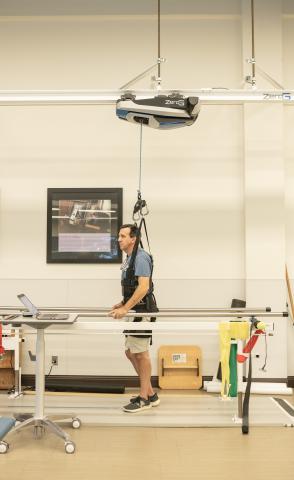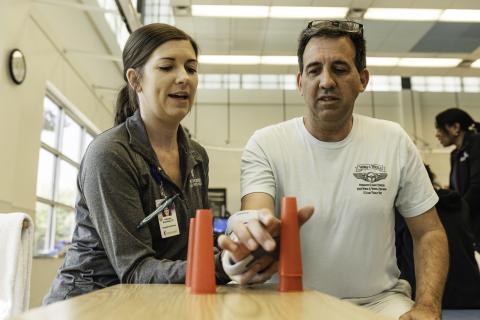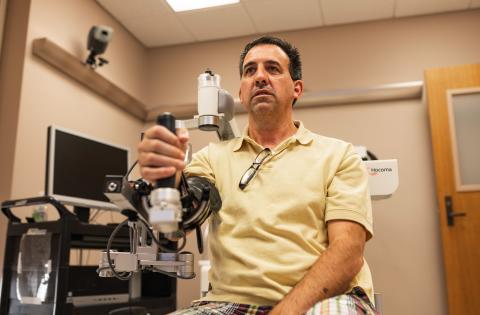
'He's bound and determined to get back'
Teamwork, technology and tenacity put Raymond stroke patient Darryl Blakely on fast track to recovery



No offense, but I don’t want to be here,” says stroke patient Darryl Blakely of Raymond.
He’s in the middle of a strenuous workout session, so Methodist Outpatient Therapy physical therapist Molli Sorrels could take the comment as a complaint.
But she understands the deeper meaning and says: “I don’t want you to be here, either.”
HERE is the middle ground between fighting for your life and reclaiming your lifestyle.
“My lowest point is when I dream at night of all the things I could do, and I get up in the morning and am reminded I have limitations,” Blakely said.
To his credit, 55-year-old Blakely treats those moments as a wake-up call to keep pushing. He’s determined to overcome one-sided paralysis common to stroke survivors. And in Methodist Rehabilitation Center, he believes he’s found the best partner for his rehab journey.
As the state’s premier rehabilitation and research hospital, MRC is a sought-after rehab setting for stroke survivors. Blakely is among 471 stroke patients served in fiscal year 2023.
A major reason is MRC is on the forefront of technology targeted to the needs of patients like Blakely. Its research center has a 4,500 square-foot space filled with more than $700,000 worth of robotic therapy devices. And MRC is also home to two of the three ZeroG Gait and Balance Systems in the state—one on the hospital’s stroke floor and another in the neuro-centric therapy gym in Flowood.
It’s the latter ZeroG that has Blakely sweating this morning. “I tell them all the time they test my deodorant,” he said.
Strapped into a ZeroG harness that prevents him from falling, Blakely is working hard to improve his balance. As he walks through an obstacle course created by Sorrels, she uses the system’s harness controls to jerk him forward and backward without warning.
“With stroke, you have weakness on one side. And that weakness causes decreased ankle strength and can affect balance,” Sorrels explained. “We’re working on his catching balance … training in harder ways so in real life he has those skills. A big reason he’s come so far is his dedication and drive to work on things to get better.”
Blakely said it certainly helps that the ZeroG harness won’t let him fall. “It gives me confidence,” he said
It’s a long way from the uncertainty he felt in the days after an April 27 stroke paralyzed his right side. “I learned how you can go from running four miles a day to not being able to take two steps the next day,” he said.
“For weeks, he needed total care,” said his wife, Heidi. “Now, he probably does 95 percent of everything on his own.”
That percentage includes some things she wishes he’d wait for her to do.
“One day he said: ‘I’m tired of this shower chair,” Heidi remembers. “I went outside and said I’d take care of it later. Then I heard a terrible noise from the bathroom. He’d taken the chair out of the bathroom, and he threw it in the closet.”
Blakely’s stubborn pursuit of independence was evident the moment he began inpatient therapy at MRC.
“One thing about him was he was willing to try anything,” said physical therapist’s assistant Tanya Rogers. “Between his prior strength and motivation, nothing is going to stop him. He’s bound and determined to get back.”
A veteran of 10 half-marathons and a duathlon, Blakely said his current state is humbling. But he’s more apt to count his blessings than to throw a pity party. “I haven’t got upset or mad and haven’t really cried,” he said. “I set my goals high, but I will accept if I don’t meet them.”
Having learned “life can change on you in just a second,” he’s set on embracing the here and now. These days, he’s focused on what’s still ahead in his recovery. “If I could open my hand, I’d feel like I’ve come full circle,” he said.
With that goal in mind, he’s turned to another high-tech tool at MRC—the Armeo Spring therapy system.
Located in MRC’s Center for Neuroscience and Neurologic Recovery, the robotic exoskeleton aids in restoring movement to the upper arm and shoulder by pairing an assistive movement device with a virtual reality training program.
MRC introduced the innovative system to Mississippi. And after treating some 100 patients with the device, occupational therapist Adrienne Brumfield said: “I’ve never had a patient say they didn’t like it.”
Brumfield said patients benefit because the adjustable arm support allows them to do high repetitions and high intensity exercises. The system also comes preloaded with 20 game-like movement exercises, which can be adjusted to address problems related to a patient’s range of motion, strength or gross motor coordination. “It keeps them engaged because they are reaching for targets, and they get competitive,” she said.
Brumfield said the Armeo is helping Blakely with his biggest issue—the ability to pick his arm up in front of him. “That’s common for stroke patients because their arm is heavy. The Armeo takes away gravity resistance and gives you arm support to move more freely. It also helps form muscle memory and endurance.”
Another plus is it isolates muscle movement, keeping users from compensating with muscles that haven’t been damaged by their stroke. And the advantage for therapists is it provides an objective measure of a patient’s progress, allowing them to grade the treatment so they can be successful.
“Without the Armeo, Darryl would probably be able to reach two times and be tired. With the Armeo, he’s able to reach farther up without support and do it for five minutes with way more repetitions,” Brumfield said. “He’s been very positive throughout the entire process, which is probably why he’s come so far.”
“I’m a big believer in if you don’t go one step past what you think you can do, you don’t get stronger,” he said. “If you don’t try, you don’t know if you can do it.”
Brumfield and Sorrels hope to take Blakely even farther with the addition of therapy using the Bioness Hand Rehabilitation System and the Bioness L300. Both devices employ low level electrical impulses to activate and retrain muscles and nerves.
The hand system will target his hand and wrist, while versions of the L300 will focus on aiding the lifting of his knee and foot.
Unless he’s in therapy, Blakely refuses to use his cane. “I’ve gone 23 weeks without falling,” he said.
Blakely does about 20 hours of work each week as a property manager. He’s also proving to be useful on the home front, checking the mail, taking the garbage out, doing dishes and laundry and feeding the dogs.
Throughout her husband’s recovery, Heidi has been diligently keeping track of his medical history. And she said his Methodist team was on board from the beginning.
“I kept every vital sign, every medicine and everybody knew and would stop and tell me what was happening so I could write it down. Not once did they act like it was imposition. We’ve been very, very pleased with our care, with our nurses and all the rehab staff. Everyone is so friendly."
"This place is just great,” Blakely added. “They motivate me and let me challenge myself. Everyone truly cares about what they’re doing.”
